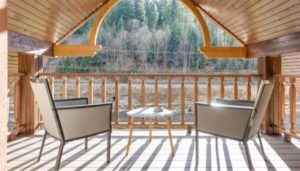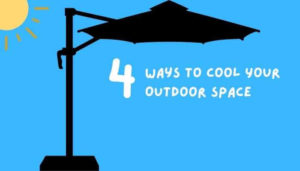In an earlier article, I compared a Pergola and a Gazebo. And I thought I was done. But someone brought up the subject of a cabana. Someone wanted to know what the difference was. And I plan on telling you.
Gazebos and cabanas are structures made with solid roofs to offer protection from the sun and rain. Builders can use the same materials for either. However, a gazebo has open sides, whereas a cabana has at least 3 enclosed sides. You can’t confuse either with a pergola, which has an open rooftop.
Cabanas have shifted to mean different things these days, thanks to mass marketing interpretation. I’ll compare a traditional cabana to a gazebo. Then I can direct you to the article I previously wrote that includes a pergola on top of all that. Hopefully, you can make an informed decision about what you need in your backyard space. Just keep reading to find out!
What is a Cabana?
A traditional cabana has always been an enclosed outdoor space wherein people can rest, eat, and maybe even change clothes. Some even have plumbing provided. When I was growing up, my aunt had a gazebo out in her yard and a pool in the backyard.
In the backyard, she had a cabana built. The cabana was an enclosed structure with a door. They screened off the main portion of the cabana to keep bugs out. It had tables, chairs, and a television. There was a completely enclosed bathroom on one side with hooks down the wall for people to use for towels and bathing suits.
The modern definition of a cabana is simply an outdoor structure that offers protection from the weather, which has at least three walls and only one opening. Cabanas are most often found near a water feature, like a pool. Most of them have three walls and then a large open wall and they have furniture inside to make them comfy.
What is a Gazebo?
A gazebo is a building structure made for protection from sun and rain but has no solid walls or perhaps just one solid wall and a solid roof. There is the traditional round (octagonal or hexagonal) gazebo and then there are the newer mass-marketed metal gazebos that may be square.
Gazebos might have seating inside. They often have railings or something that separates the inside from the outside.
Custom gazebos are often the focal point of a property, usually placed where people can have a nice view and enjoy themselves. People might even use the larger versions for big family get-togethers. I know a lot of wedding photographers love using gazebos of any size as a stage for pictures.
Unlike pergolas, which have open tops, gazebos can actually protect you from a hard downpour just as much as they can protect you from the harsh sun.
What is the Best Material for Making a Gazebo or a Cabana?
Professionals make most gazebos and cabanas with wood or polycarbonate wood material. Wood makes up for most of this, and it costs less than composite. As of May 2022, pressure-treated pine sold for approximately half what the same amount of composite wood costs.
However, that doesn’t mean it’s better. Wood doesn’t last as long and you have to maintain the wood with quarterly treatments to get even close to the same lifespan.
Premium woods like cedar and redwood cost almost as much as composite and you still have to maintain them. But you could get as much as 40 years out of those. Even though the product guidelines tell me that composite wood lasts 20+ years, it definitely can last as long as 50. Any poly-composite wood will last longer and have less maintenance to worry about. The furniture made from this recycled product lasts for years and years.
There are mass-market gazebos made of fabricated metal or aluminum as well. These structures, when properly seated and maintained, can last for as long if not longer than the other two I’ve mentioned. Be sure to use treated metal or paint it to keep oxidation from occurring (rust).
Metal mass-market gazebos are usually cheaper than standard gazebos and we’ve had one. It was very nice, and I’d love to have another one. Unfortunately, where we live is in a hurricane zone and it’s not recommended to use those gazebos.
Should I Have a Gazebo or a Cabana in my Backyard?
The question is, what functions do you want the structure to accomplish? What do you plan to use your structure for? This is very important. Also, what kind of space do you have available for it? You may want to hire a landscape designer to help you get this project accomplished. Then, you’d have fewer headaches.
I would definitely hire professionals to make these buildings happen, even if I bought a pre-fabricated metal gazebo.
They would know what the legal zoning was in your area. They would also be responsible for getting all paperwork and permitting and then having the site inspected. If anything happens, having a licensed and insured professional means that you always have something to fall back on.
I would caution you not to purchase any prefabricated gazebos (or any large structures) until you know what is legal in your area. We had to have an inspector be sure ours met code and was specific footage away from our property line.
Also, we had an unfortunate loss of money when we had to return a prefabricated gazebo. It seems there is a wind rating on these structures and ours did not meet local guidelines. We’re in a hurricane zone. You need to be aware of these possibilities.
In Conclusion
I hope the article helped you decide or at least helped you understand the differences between these two outdoor structures. Figure out which structure you should plan for and what materials you want to use for that structure. Those are the most important considerations when you are planning out the backyard. But you know, if nothing else, you learned some vocabulary, right?












